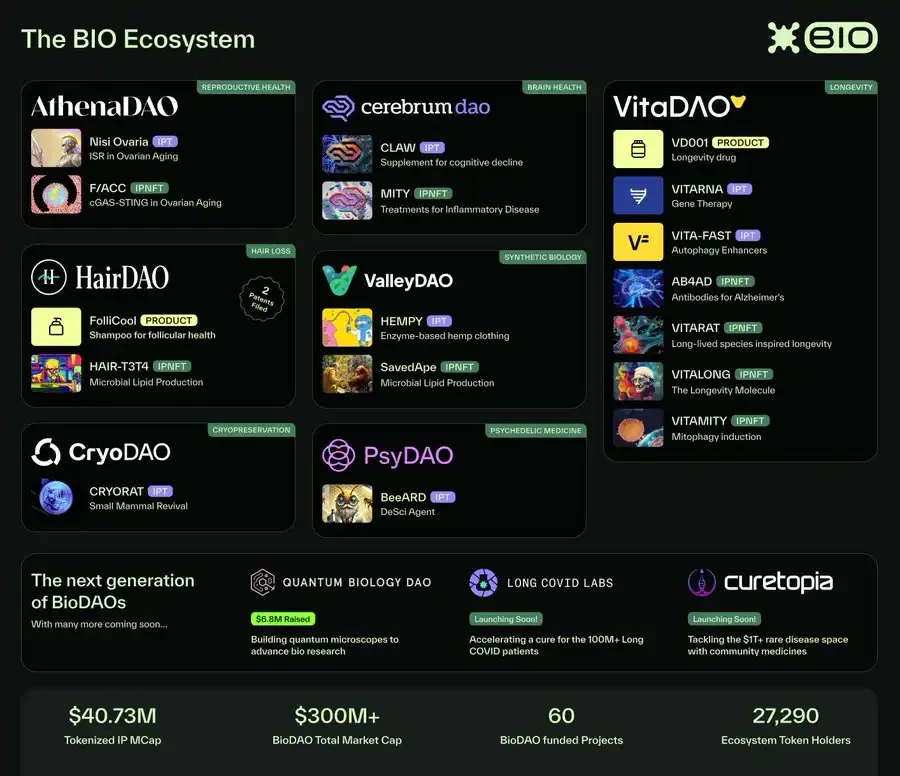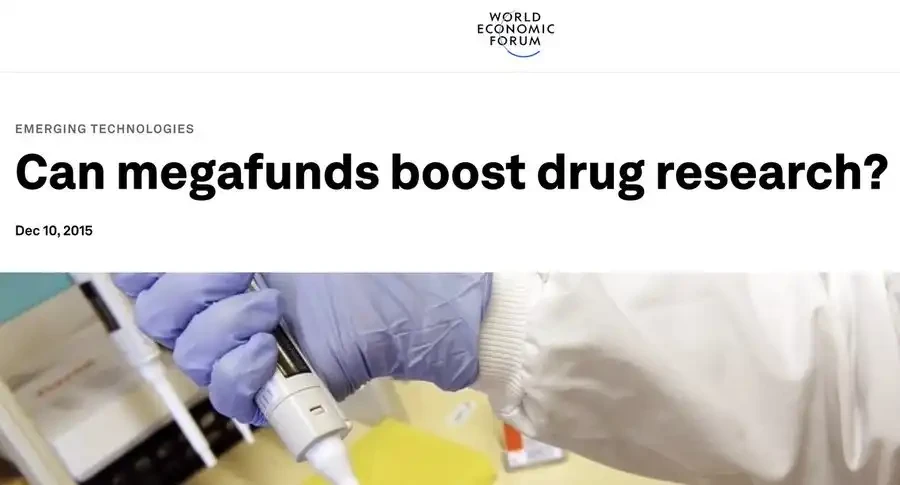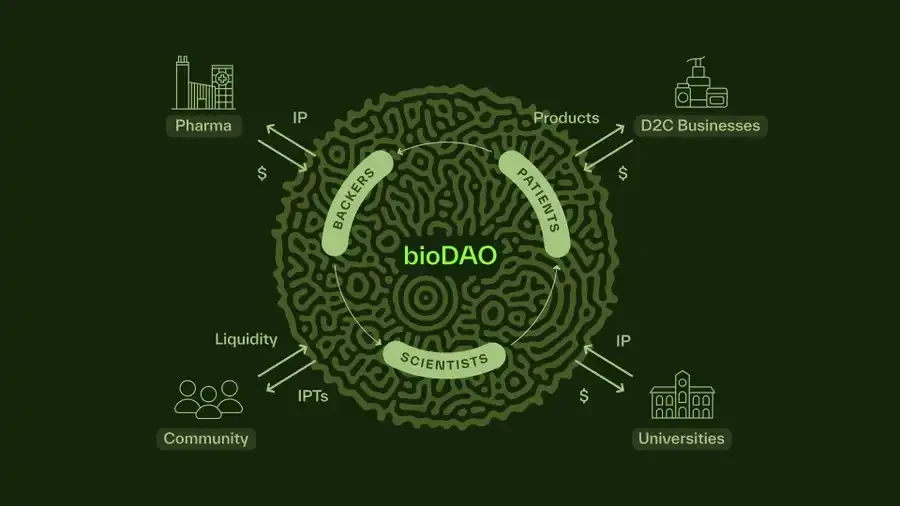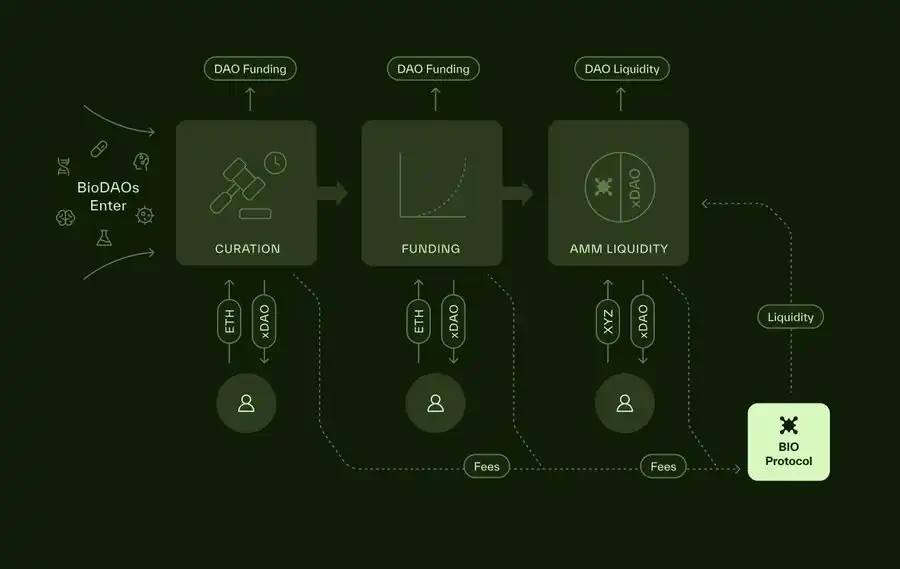New article by BIO founder: From science fiction to scientific finance, how does Desci drive the biotechnology revolutio
Original title: From Science Friction to Science Finance: A Community-Driven Revolution in Biotech
Original author: Paul Kohlhaas, founder of BIO Protocol
原文翻訳: zhouzhou、BlockBeats
編集者注: This article describes how the BIO protocol solves funding, RD, and market issues in the biotechnology field through the decentralized BioDAO network. Through tokenized intellectual property, decentralized governance, and real-time liquidity, BIO enables Patients, scientists and investors jointly participate in decision-making to support neglected areas such as rare diseases and long-term COVID-19. BIO breaks through the traditional fund structure, promotes innovation in biotechnology, accelerates the scientific research process, and achieves more efficient and fair capital flow and achievement transformation. , ultimately driving scientific progress and global impact.
以下は元のコンテンツです(読みやすく理解しやすいように、元のコンテンツを再編成しました)。
“We live in a society that is exquisitely dependent on science and technology, and almost no one understands it.” —Carl Sagan
要約
-
The Broken Biopharmaceutical System: Science at a Bottleneck
-
Andrew Lowes Big Fund Theory: A Milestone in Biotech Finance
-
Beyond Mega Funds: The Emergence of the BIO Protocol
-
From Fund to Ecosystem: Advancing Lowe’s Vision in the BioDAO Network
-
BIO Protocol Practice
-
Orphan drugs, rare diseases, and long-term COVID-19: The moral and economic fit
-
Lessons from mega-fund-inspired biotech holding companies
-
From scientific friction to scientific finance
-
Bottom-up funding evolution
A universal truth hangs over our modern age: Scientific knowledge is exploding, but life-changing treatments—for everything from long-term COVID-19 to rare autoimmune diseases—remain out of reach for millions. This stark contrast reveals a twisted paradox: the problem is not scientific impossibility but inefficiency in market structure.
Big Pharma is investing billions of dollars in chasing the newest and greatest by making incremental improvements to existing drugs (e.g., enhancing existing PD-1 cancer drugs or GLP-1 anti-obesity drugs) through strategies such as patent lifecycle management. Hot clinically validated drug targets in a highly competitive market—while research into patient needs is languishing.
The result? An industry mired in scientific friction, where bloated costs, capital bottlenecks, and intellectual property silos slow potentially transformative innovations or put them on hold altogether.
1. Broken biopharmaceutical system, science encounters bottleneck
Every day, thousands of people struggle with complex, debilitating, and underfunded diseases like long-term COVID. Many are finding that research to help them isn’t scientifically “difficult”; it’s the return on investment for traditional pharmaceuticals that’s so high. It’s just a symptom of a broader crisis, as revealed by Eroom’s Law: As biotech RD spending soars, the productivity of discovering new drugs plummets. How did we get here? ?
1.1 The Valley of Death and “Safe Bet”
Promising discoveries made in academia often have difficulty transitioning to early clinical research because no one is willing to fund the perilous transition period between animal testing and human trials. This notorious “valley of death” stymies potential treatments that Big Pharma sees as having neither profit potential nor too risky.
Many venture capital and pharmaceutical companies adopt a “fast follower” strategy, waiting and hoping that other companies will successfully address these risks. These risks may include decoding the pathophysiology of the disease, solving regulatory challenges (such as the lack of clear clinical endpoints), and uncertain The commercial desirability of pharmaceutical mergers, or the dynamics of health insurers in reimbursing treatments. It’s a minefield of incentives and constraints, but it doesn’t leverage any collective mechanisms to empower patients’ voices.
1.2 Excessive concentration of capital
The main funding channels for biotech—Big Pharma and large venture capital firms—tend to focus on “hot-selling” categories. More than 90% of biotech capital is concentrated in highly competitive, less differentiated areas, resulting in the loss of once promising Breakthrough research in areas such as longevity, complex immune system diseases, or neurology has stagnated.
While these low clinical risk and commercially attractive therapeutic areas are very attractive to pharmaceutical companies and venture capitalists, many also represent the most expensive failures, as only 5% of approved and marketed drugs achieve Realize best-selling sales potential.
Otherwise, it is a huge waste of RD dollars. In Bruce Booth’s famous Atlas 2024 Review, Bruce commented that less than 15% of biotech financing rounds have received more than 66% of available risk. Investment funds, which is a huge change from where we were 10 years ago. We need more meritocratic mechanisms to deal with public health issues and the coming tsunami of aging in Western societies.
1.3 Intellectual Property Lock-in and Data Silos
Under the existing business model, knowledge is trapped behind thick patent walls and closed-door deals, slowing progress. Labs around the world often repeat the same high-cost experiments due to a lack of shared insights, adding unnecessary Friction. Patient data and clinical insights are so fragmented that they could have significant inferential value under a unified data architecture, but are blocked by the bureaucracy of hospital administrators, data aggregators, and biobanks alike. troubled.
Intellectual property rights can be time-limited, and only certain forms (such as composition of matter patents) are of significant value to venture capitalists and pharmaceutical companies, which is consistent with the longevity community’s interest in repurposing drugs such as rapamycin, allantoin A, and metformin. Overall, inefficiencies in resource allocation and commercial constraints inhibit real-world health transformations, and real-time transparency could help alleviate some of these problems.
1.4 Opaque RD and Limited Accountability
The process of developing a pipeline is slow and convoluted. Funding flows are hidden; outsiders cannot see if (or why) a trial fails until it is too late. Accountability is limited, leaving patients and the public in the dark.
Management and RD teams change constantly, and as the teams change, so do the pipelines. Companies like Roivant have built large and successful businesses by licensing and developing strategically shelved drugs.
1.5 Capital lock-up periods of more than 10 years inhibit innovation
Traditional biotech investments often take a decade or more to pay off — a near-eternity in a fast-paced market. This illiquidity leads to a lack of funding for early-stage research, especially when outcomes are uncertain. Down.
Biotech competes with other asset classes for capital allocation when clinical and scientific explanations of drug therapeutic potential are less clear (e.g., revenue/EBITDA growth, etc.). In this context, the open community helps compensate for the relative relative affordability of these therapies. Value gaps in education and socialization.
Biotech is at a disadvantage in attracting investors and gaining market share, while other health-related topics, such as longevity, have become cultural phenomena. Certain biomedical breakthroughs, such as statins, PD-1 inhibitors, or anti-obesity drugs, have become more popular than ever before. ) demonstrate impressive commercial potential (e.g., Obesity 5 (NONO, LLY, AMGN, ZEAL, and VKTX) yields 93% in 2024), but investment structures require significant revision to ensure the value of these transformative innovations is not diluted and ensure better investor accessibility — this is where tokenization will bring change.
Eroom’s Law runs counter to the tremendous scientific progress we are experiencing – such as Deepmind’s AlphaFold 2, the 2024 Nobel Prize in Chemistry, mRNA therapeutics, GLP-1, cell and gene therapy, etc. Business and stakeholders in the pharmaceutical and biotech industries Models rarely question, and if they can help improve operating structures that are more efficient, they will be welcomed.
Andrew Lowes Big Fund Theory: A Milestone in Biotech Finance
In 2012, MIT professor Andrew Lo and his collaborators proposed the concept of a “megafund”—a large, diverse pool of early-stage drug candidates. The combination of assets can spread risk: a single biotech startup may go out of business if its sole treatment fails, but a portfolio can withstand multiple failures as long as the few successful projects can generate returns.
This theory groundbreakingly points out the structural inefficiency of how we fund life science RD. However, Lowe’s approach is still top-down: big checks from institutional investors, funding allocations at the top, and ordinary scientists or patients have little opportunity to participate in meaningful decision-making.
3. Beyond Mega Funds: Enter the BIO Protocol
Now, a new wave of decentralized science is emerging to further Lowe’s vision. The BIO Protocol borrows from the core idea of megafunds—managing risk through broad diversification—but reimagines that diversification, Governance and capital formation. Rather than being a single giant fund managed by a central authority, the BIO protocol:
-
As a decentralized token holder governance protocol, curating and incubating BioDAOs. These are dedicated bottom-up communities that own and ガイド RD through an on-chain research portfolio.
-
トークンizing intellectual property and data through IPTs (Intellectual Property Tokens) makes them tradable, liquid assets, giving BioDAO’s researchers and community access to liquidity earlier than is common in the biotech industry.
-
Deploy capital in real time and enter the Valley of Death directly.
-
Putting patients, scientists, and everyday people at the core is like a Reddit community with a shared bank account.
3.1 Permissionless Stakeholders
In BioDAO, anyone directly involved with a disease — be it a patient, clinician, or scientist — can join through on-chain governance. Rather than passively hoping that “someone” will fund their cause, they can collectively participate in the project through 暗号currencies. Funds raise capital, form DAOs, and collectively source research ideas from internal and global scientists, deciding how to allocate and prioritize resources.
3.2 Tokenized Intellectual Property and Data
BioDAO issues IP tokens (IPTs) through @molecule_dao, which represent decentralized governance rights for research. These tokens can be licensed, traded, or pooled, effectively providing a new way for DAOs to deploy funding based on milestones. To gradually reduce the risk of early science. Sharing data and data replication is no longer an afterthought, but a core, liquid asset that can drive scientific discovery. It is also possible to issue bonuses to various researchers, creating a decentralized science and incentives for drug discovery.
3.3 Bottom-up capital formation
Unlike mega-funds that rely on large institutional investors, the BIO Protocol coordinates community-driven fundraising. Through its launchpad, BioDAO founders can pitch their research, set up private or public token sales, and stake their stakes through governance rights. Reward early backers – no vetting by VCs or Big Pharma required.
4. From Fund to Ecosystem: Advancing Lowe’s Vision in the BioDAO Network
4.1 Meta-portfolio of decentralized centers
Rather than a single entity holding 200 assets, the BIO Protocol facilitates a governance treasury with thousands of BioDAOs, each focusing on a specific scientific niche. This greatly expands the possibility space while It also allows the community to govern itself. There is no single manager making decisions; instead, the protocol guides the asset development, risk management, and synergies of all these DAOs through its community of token holders.
4.2 Permissionless Launchpad and Acceleration
BIO’s real-time decentralized launchpad mechanisms — such as bonding curves or auctions — enable new BioDAOs to launch quickly. Early stakers or token holders can indicate which areas are worth investing in. This The approach both democratizes biotech funding and accelerates the flow of funds to neglected areas such as long-term COVID-19 or rare autoimmune diseases.
4.3 On-chain risk management
Megafunds mitigate risk through portfolio theory, as does BioDAO, but on-chain analytics enables them to share standardized reports on clinical milestones, IP valuations, and treasury data. This facilitates real-time insights, allowing the protocol to leverage its own risk by allocating funds to Multiple DAOs, or by establishing research-based obligations to further spread risk or rebalance.
4.4 Continuous Liquidity and Evergreen Capital
Traditional funds lock up capital for a decade, while BioDAO’s tokens and IP tokens remain liquid, allowing participants to exit or redeploy capital. If a BioDAO’s therapy begins to show promise, it will naturally attract more liquidity. The game theory here is that treatments will naturally become Schelling points for capital. At the same time, revenue from successful treatments will flow back to the protocol treasury (BIObank), recycling capital into new or existing DAOs. middle.
5. Protocol Practice: A Holistic, Bottom-Up Ecosystem
Imagine a team of scientists proposes a new “NeuroDAO” that aims to develop innovative treatments for traumatic brain injury. They upload preclinical data and funding roadmaps to BIO’s user-friendly launch platform. The global BIO community stakes tokens to create a new NeuroDAO. to approve or reject the proposal—no little committee operating behind closed doors. Once approved:
-
NeuroDAO mints its Intellectual Property Tokens (IPTs).
-
These tokens are sold through a bonding curve or auction to raise initial capital.
-
As milestones, such as preclinical endpoints, are achieved, additional capital will automatically unlock.
-
The wider community can track progress, invest further and accelerate the flywheel effect.
If NeuroDAO reaches a major breakthrough moment — such as discovering a new molecule that speeds brain recovery — an IP licensing agreement could funnel revenue into the coffers to fund further research. This mechanism creates a sustainable flywheel. effect, driving an evergreen, self-reinforcing cycle.
Since its inception, the BIO ecosystem has grown rapidly. In less than two years:
-
8 BioDAOs have been funded
-
Raised $30 million for research
-
Tokenized intellectual property value exceeds $50 million
-
BIOs AUM exceeds $60 million
-
$8 million has been allocated to BioDAO-funded scientific projects to date
-
60 active RD projects
-
34,000 ecosystem token holders (3,716 of whom hold BIO governance tokens)
Multiple BioDAOs have rapidly advanced from seed-stage research to advanced preclinical research, validating the premise that decentralized capital plus open collaboration can accelerate biotech innovation. 
Orphan drugs, rare diseases and long-term COVID-19: The moral and economic fit
Long Covid is just one example of an “unpopular” but urgent condition. Similarly, orphan diseases — those that affect smaller patient populations — are often ignored by big pharma because they see limited profit potential.
But in a network like BIO, patient-led or family-led BioDAOs can be formed around any disease, using new structures to fund research that large companies are reluctant to fund. Smaller patient groups can speed up clinical trials and shorten timelines. , and unlock impressive returns without a “hit or bust” mentality. The moral alignment is clear: this isn’t about market size, it’s about impact.
7. Real-world momentum: Lessons from companies inspired by megafunds
Prior to decentralized science, multi-asset risk-sharing models have been tried in different forms:
-
BridgeBio (NASDAQ: BBIO): Focused on rare diseases with a hub-and-spoke pipeline.
-
Roivant Sciences: Launching independent “Vants” for each therapeutic area to integrate management expenses and capital.
-
Royalty Pharma: A portfolio of multi-billion dollar diversified royalty income streams that demonstrates that securitization can provide consistent funding for pharmaceutical intellectual property.
These companies all embody Lowe’s principle of diversity. The BIO Protocol takes this principle a step further by democratizing access, distributing governance, and enabling continuous liquidity through tokenization.
8. From Science Friction to Science Finance (SciFi)
Close your eyes and imagine that it is 2026. Under the BIO framework, there are already hundreds of BioDAOs, covering a variety of diseases from pancreatic cancer to autoimmune hair loss. Each DAO is led by patients, researchers, and philanthropists. A community of collective thinking of supporters. They:
-
Access real-time research data shared across your network to accelerate every clinical turning point.
-
Coordinate clinical trial participants and best practices (if multiple BioDAOs are addressing related areas, the BIO can facilitate shared trial participant pools, data registries, and best practice governance, reducing administrative overhead).
-
Use AI to assess risks, potential synergies, and capital allocation.
No longer are breakthroughs limited by decade-long funding lock-ins or heavily guarded institutions. Instead, the entire network is like a living, breathing organism—fluid, adaptable, and open.
8.1 The Golden Age of Biotechnology
By “tokenizing everything,” from preclinical data to final-stage intellectual property, coupled with decentralized governance, BIO is bringing the industry’s biggest friction points to light. Suddenly, drug development feels more like science fiction than fiction. A long marathon.
8.2 Inclusive Community, Global Impact
This revolution isn’t just happening in the lab. Ordinary investors — people who may have a loved one with a rare disease — can stake tokens to support new research and see transparent progress as it happens. It is not a buzzword, but an on-chain reality that drives the formation of multinational research teams.
8.3 Reversing Erooms Law
As friction is removed and communities from any region can access global funding, we may finally see the cost/time curve for drug development bend downward, rather than upward—delivering the exponential scientific progress that was originally promised.
9. The bottom-up evolution of biotech financing
Andrew Lowes mega-fund theory points us to an important path: large, diversified portfolios can tame the high risk of biotechnology and attract larger capital. However, top-down structures and institutional inertia still exist. In contrast, the BIO protocol flips this script:
-
Community-driven: Anyone with a stake in the project — a patient, a scientist, or a curious funder — can participate in governance, propose new BioDAOs, and collectively shape the direction of research.
-
Tokenized IP: Data and IP become liquid, paving the way for new funding and collaboration models.
-
Real-time liquidity: Freed from a decade of funding lock-in, capital can flow quickly to breakthrough innovations.
-
AI-driven risk management: On-chain analytics continuously tracks performance, synergies, and correlations, allowing capital to flow efficiently across multiple BioDAOs.
By stacking decentralized science solutions (via BioDAO) with BIO’s top layer coordination (launch platform, funding, liquidity, meta-governance), the most difficult challenges in science and pharma can be solved in a community-driven, transparent and sustainable manner. solved in a fluid environment.
Putting families, patients, and scientists at the heart of decision-making, BIO aims to “boil the ocean” and solve the dilemma of early-stage innovation. No longer will half of the world’s great ideas rot in the “valley of death.” Instead, we are witnessing a The dawn of an unfettered age of science, freed from the old gatekeepers and friction-filled pipelines.
So the next time a family member faces a rare disease, the deciding factor will not be a boardroom analysis of market size, but a global network of scientists, patients, and everyday believers working together to coordinate, fund, and accelerate the research that really matters. In short, we are back in the world of science fiction, where humanity finally unites to transform the impossible into the inevitable.
This article is sourced from the internet: New article by BIO founder: From science fiction to scientific finance, how does Desci drive the biotechnology revolution?
Original | Odaily Planet Daily ( @OdailyChina ) Author | Asher ( @Asher_0210 ) Secondary market performance of blockchain gaming sector As of today, according to Coingecko data, the Gaming (GameFi) sector has fallen by 14.6% in the past week; the current total market value is $ 30,079,056,493 , ranking 44th in the sector ranking, down 4 places from the total market value sector ranking last week. In the past week, the number of tokens in the GameFi sector has increased from 627 to 630, with 3 projects added, ranking 5th in the sector ranking, second only to DeFi, NFT, Meme, and Finance/Banking sectors. Among the 630 gaming projects that have issued tokens, only 15 projects have a positive increase, among which My Lovely Coin project token MLC leads the…











